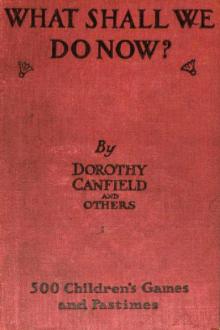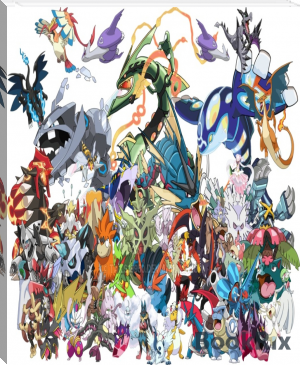What Shall We Do Now?, Dorothy Canfield Fisher [ebook offline reader .txt] 📗

- Author: Dorothy Canfield Fisher
- Performer: -
Book online «What Shall We Do Now?, Dorothy Canfield Fisher [ebook offline reader .txt] 📗». Author Dorothy Canfield Fisher
Wheat or Canary Seed.—Wheat or canary seed can be sown in any kind of dish, the bottom of which is covered with wet moss. Sow the seed thickly and then keep the dish in a dark cupboard until the seedlings are about two inches high. Then place it in a sunny window. The seed, which will take about three weeks to grow, makes a beautiful patch of clear light green in a room. Keep the moss wet.
Mustard and Cress can be sown in pots or on pieces of wet flannel.
Campanulas.—Blue and white campanulas are grown in almost every cottage window, and they are very beautiful and graceful. They can be grown in pots, but are prettiest in baskets from which to hang down.
Fuchsias and Geraniums.—Both fuchsias and geraniums are gay and delightful plants for a room. Good kinds should be bought in early summer and well watered. In winter the plants should be kept in a cool dark place, until with the coming of spring they begin to grow again. Both can very easily be increased by cuttings. To do this take off a shoot of about four inches long, cutting it off just below a joint. Then pull off the leaves just above the joint and put it into some earth in a sunny corner and water it well. In about a month roots will have formed and it can then be potted.
Bulbs.—Bulbs, such as tulips, iris, daffodils, crocuses, scillas, and snowdrops, can be grown in pots or deep earthenware saucers that have been filled with cocoanut fibre. This can be bought at any florist's. A little shell, shingle, or sand, can be mixed with the fibre, and a piece of charcoal should be put at the bottom of the pot to keep it sweet. The bulbs need only to be covered with a thin layer of damp fibre. Water regularly, as they must never get dry. If your pot has no drainage hole it is a good thing a little while after watering to turn it gently on one side so that any water which has not been soaked up by the fibre can run off.
Bulbs can also be grown indoors in earth. Plant them in October just below the soil, and keep them in a cool dark place until they have made a little growth. Then bring to a sunny window. Horsfieldii narcissus, polyanthus-flowered narcissus, and yellow jonquils, grow well, and so do tulips, hyacinths, and crocuses. In a sunny window the Scarborough lily (Vallota purpurea) can be grown. It is a very gorgeous and imposing red flower which blossoms in August and September. It should be planted in autumn and plenty of room allowed for its roots.
The Good-Luck Lily, which is a strong and beautiful polyanthus narcissus, can be grown in bowls filled with pebbles and water. Fill the bowl almost to the top with clean pebbles (which can be brought from the seashore), and among them plant the bulbs and fill up with water which must be added to as it evaporates. Among the pebbles put two or three pieces of charcoal.
Bulbs in GlassesHyacinths and daffodils can also be grown in glasses filled with water, either glasses sold for the purpose, or any kind into the necks of which the bulbs will fit. The bulb should be placed in the glass in October, and should not quite touch the water. Use good fresh water and put a little piece of charcoal in the glass. Change the water once a week. In warm sunny weather the hyacinths can be put out of doors for a little while every day.
Window BoxesOne cannot grow very many things in a window box, but it is most interesting to grow a few. In a town it is often all the garden that many people possess.
The length of a window-box will depend on the size of the window. Its depth should be ten inches at least. At the bottom of the box some cinders or other rough material should be put, and then it should be filled up with the best earth you can get. And because of the difference it makes to the growth of your flowers it is worth while to take a great deal of trouble in getting good, rich mould. The earth may be kept level, or heaped up at one or both ends, and a few stones added to make a tiny rockery, in which you can grow small saxifrages and other rock plants.
Flowers for Window-BoxesNasturtiums and canary creeper can climb up a little trellis made of sticks at each end of the box, or they can cling to strings fixed to the box and nailed high up at the side of the window. Wandering Jew or ivy-leaved geranium will fall over the front of the box and make it look very gay. Bulbs, such as winter aconite, squills, snowdrops, a few daffodils, tulips and irises, will grow well in boxes. These should be planted rather deep. Then primroses and forget-me-nots can be planted, and in May a border of lobelia, one or two geraniums, pansies, fuchsias, a plant of lemon verbena, and some musk. Mignonette, Virginia stock, collinsia, should be sown in spring in little patches or lines.
Keep the leaves of all the plants as clean as possible by gentle watering with a rose. Never let the earth get dry from neglect, or sodden from too much watering; yet water well, for driblets only affect the surface, and it is the roots far down in the box that need moisture.
Cutting Flowers and Packing Them—Flowers for PostIt is best, if possible, to pick flowers the day before you want to send them off. Pick them in the afternoon, sort them and bunch them up, and then stand them in water right up to their heads, and keep them there over night. A basin is the best thing to put the flowers in, unless the stalks are very long, and a jam-pot or two in the water will help to keep them from tumbling over and drifting about. Be very careful that the blooms do not touch the water. Keep the flowers in water until you are ready to pack them. Tin boxes are best to send flowers away in; but generally one has to use cardboard ones. Choose the strongest you can find and line it with two sheets of paper, one across and one long ways, and each long enough to fold over when it is full. Then line again with some big cool leaves or moss. Dry the flowers and pack them as tightly as possible, taking great care not to crush the petals. Cover them with a few more leaves and fold the paper over. Then wrap up the box, remembering to write the address on a label tied at one end of the box, so that the postmark will not be stamped on the box itself and perhaps break it.
Picking FlowersWhen you are picking flowers to send away, never pick old ones. Buds are best generally, especially in the case of poppies; but they should be buds just on the point of opening. Always use scissors to cut flowers with. A very slight tug at a little plant in dry weather pulls its roots out of the ground. Cut the flowers with long stems and with some of their green leaves, and at the top of the box that you are sending away it is pleasant always to put something which smells very sweetly—lemon verbena, or mignonette—for that first sweet scent is one of the very best things about receiving a present of this kind.
The Reception of FlowersWhen flowers are sent to you, each stem should be cut with a slanting cut before you put it in water. Flowers with very thick or milky stems should be slit up about half an inch, and woody stems are best peeled for an inch or two. Put the flowers deep into water that has had the chill taken off it. Always put flowers in water as quickly as possible after they are picked. Change the water every day, and recut the stems if they look at all brown or dry.
PETS PETSIn no case do the following hints as to the care and character of pets go so far as they might. But they lay down broadly the most useful rules. In cases where a dog or bird is really ill, and ordinary remedies and treatment do not help, the advice of some one who knows should be asked. It is because all children are in touch with some one who knows, that this chapter is not longer. The aim of the writer of most of the notes which follow has been to describe those creatures which are most commonly kept as pets, with a few suggestions as to their care in ordinary health.
Dogs: Their Care and FoodAll dogs need plenty of exercise; indeed it is scarcely possible to give them too much when once they are over six months of age. After twelve months they can follow a horse, but a bicycle as a rule is too fast for a dog, and the excessive exertion is likely to make them ill. Plenty of fresh air and freedom are necessary, and your dog should never be chained except at night, when he should have a snug bed away from any draught. The house is the best place for a dog to sleep, but should he live in a kennel it must be a roomy one, filled two or three times a week with clean straw and raised from the ground about six inches so that it will keep dry. Kennels with runs in front are the best, as then the dog need never be chained. In these there should be a wooden bench for him to lie on, sheltered by a sloping roof. An earthenware trough of clean water he must always have, and most dogs will do best if they are fed twice a day: a light breakfast of biscuit or brown bread and a good dinner of scraps or dog-biscuit soaked in gravy with vegetables and plenty of rice. A rounded leather collar is best for dogs with long hair, as it does not show so much or spoil the coat, but for smooth-coated dogs a flat plain collar is best.
Washing DogsDogs should not be washed very often, nor will this be necessary if they are well brushed every day. A stable dandy-brush is best for short-coated dogs, and a hard hair-brush, or one of those with metal bristles, which can be bought in most saddlers' shops, for long-coated ones.
Common yellow soap and soft thick towels should be used when your dog really needs a bath. Have a pailful of warm water, a pitcher to dip it up with, a piece of mild yellow soap, and a pail of cold water. Pour a little warm water over the dog, beginning with his back, shoulders, and sides, and finish





Comments (0)